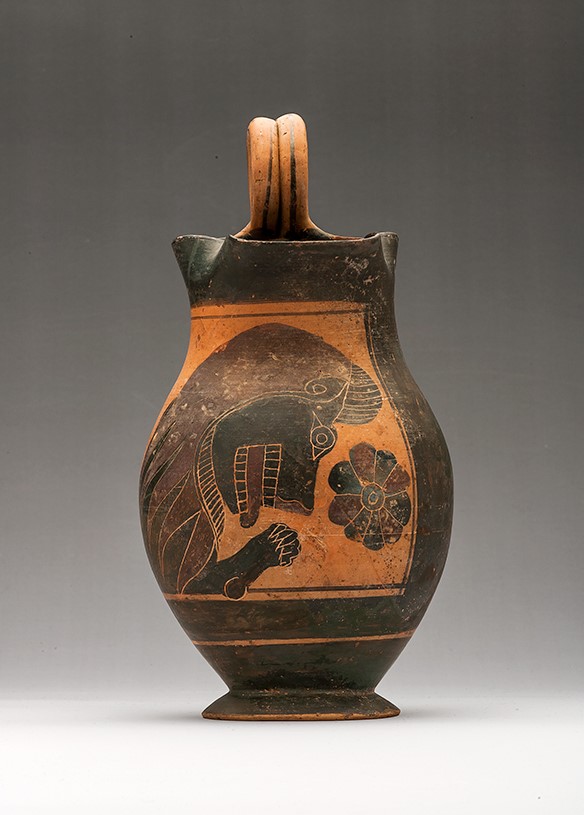Acquisition number: 1976.07
Attic Black-Figure Olpe.
The olpe has trefoil mouth and double handle; the latter is reserved and decorated with lines down the edges and on the back of each segment. The inside of the lip is painted but there is no wash inside. There is a reserved line on the lower wall; the edge of the foot and the underside are also reserved.
In the panel, which is placed off-centre, is drawn the forepart of a lion with raised paw; in the field, a rosette. Red was added for the lion’s mane, nose and tongue; also on alternate petals of the rosette.
Title: Attic Black-Figure Olpe - 1976.07
Acquisition number: 1976.07
Attribution: Manner of the Gorgon Painter.
Author or editor: J.R. Green
Culture or period: Archaic Greece.
Date: First quarter 6th century BC.
Material: Clay - Terracotta
Object type: Pottery - Black-figure
Dimensions: 140mm (w) × 215mm (h)
Origin region or location: Greece
Origin city: Athens.
Display case or on loan: 3
Keywords: Greek, Attic, Black Figure, Gorgon Painter
Fasti Archaeologici 11, 1956, pl. 4, 2; A.D. Trendall, Greek Vases in University House (Canberra 1960) 4, fig. 1; J.D. Beazley, Paralipomena: Additions to Attic Black-Figure Vase-Painters and to Attic Red-Figure Vase-Painters (Oxford 1971) 8; J.R. Green with B. Rawson, Catalogue of Antiquities in the Australian National University, A.N.U. (Canberra, 1981) 24-25. T.H. Carpenter, with T. Mannack and M. Mendonca, Beazley Addenda, 2nd edition (Oxford 1989): 3;Beazley Archive Pottery Database 350313.
1976.07
Attic Black-Figure Olpe
Lent by University House. Ht (lip) 21.5cm; diam. 14cm.
Reconstructed from fragments; some of the black has been repainted but the figure-work is not seriously affected.
The olpe has trefoil mouth and double handle; the latter is reserved and decorated with lines down the edges and on the back of each segment. The inside of the lip is painted but there is no wash inside. There is a reserved line on the lower wall; the edge of the foot and the underside are also reserved.
In the panel, which is placed off-centre, is drawn the forepart of a lion with raised paw; in the field, a rosette. Red was added for the lion’s mane, nose and tongue; also on alternate petals of the rosette.
The vase is attributed to the manner of the Gorgon Painter, a major personality in the development of early Attic black-figure. Typical are the long shaggy mane, the square teeth and the incised top-knot. The style, however, is not the painter’s: it is more rigid as well as differing in a number of details such as the very square lines of the mouth, the omission of browlines and the addition of the incised area between mane and chin. The Gorgon Painter himself usually prefers more filling ornament. See a list of his work, see J.D. Beazley, Attic Black-Figure Vase-Painters (Oxford 1956) 10-14, and the useful discussion with illustrations by I. Scheibler, “Olpen und Amphoren des Gorgomalers”, Jahrbuch des Deutschen Archäologischen Instituts 76, 1961, 1-17. Note also D. Williams, “In the Manner of the Gorgon Painter: The Deianeira Painter and Others”, in: H.A.G. Brijder, A.A. Drukker and C.W. Neeft (eds), Enthousiasmos. Essays on Greek and Related Pottery presented to J.M. Hemelrijk (Amsterdam 1986) 61-68; and J. Boardman, Athenian Black Figure Vases. A Handbook (London 1974) figs. 12-16.
For a recent overview of early Attic black-figure, see A. Alexandridou, “Approaching Early Archaic Attica: A Contextual Study of its Early Black-Figure Pottery Production”, in: R.G. Gürtekin-Demir et al., Keramos. Ceramics: A Cultural Approach (Ankara 2015) 11-24.
Figures such as this lion belong to a series of representations of powerful creatures popular at this period; one may think also of sphinxes, sirens, gorgons, and the like. They may be read as ‘terror-symbols’, images that impressed the viewer (who still saw relatively few images in his or her everyday life) through their strength and ability to frighten. See the comments by M. Robertson, A History of Greek Art (Cambridge 1975) 63-6 (on the Corfou pediment) and 90-3 with 161 on architectural sculpture from the Acropolis at Athens.
The olpe (a name conventionally applied to this shape of vessel) is the simplest form of jug and the only type current in the earlier stages of Attic black-figure. More complex varieties were developed in the second half of the sixth century, for example by the potter Amasis. Many olpai both of this date and later have the panel decoration off-centre, so that it is fully visible when the vase is used by a right-handed server. For some comments on the shape in Athens and Corinth, see M. Ramon Ribaud, “L’Olpé trilobée d’Athènes à Corinthe: ‘variations’ pour une même forme”, Revue Belge de Philologie et d’Histoire 87.1, 2009, 13-46.
First quarter of the sixth century BC.
Fasti Archaeologici 11, 1956, pl. 4, 2; A.D. Trendall, Greek Vases in University House (Canberra 1960) 4, fig. 1; J.D. Beazley, Paralipomena: Additions to Attic Black-Figure Vase-Painters and to Attic Red-Figure Vase-Painters (Oxford 1971) 8; J.R. Green with B. Rawson, Catalogue of Antiquities in the Australian National University, A.N.U. (Canberra, 1981) 24-25. T.H. Carpenter, with T. Mannack and M. Mendonca, Beazley Addenda, 2nd edition (Oxford 1989): 3;Beazley Archive Pottery Database 350313.
University House, ANU.
1 Balmain Cres, Acton ACT 2601.
(02) 6125 5211.

